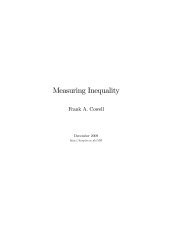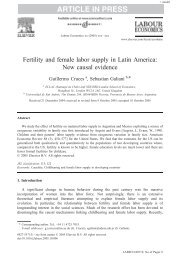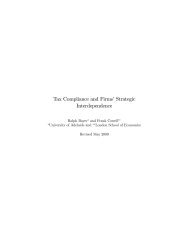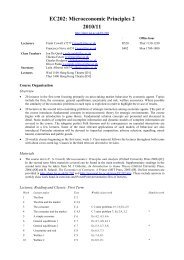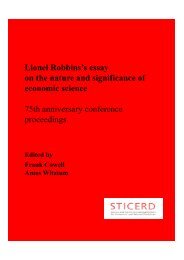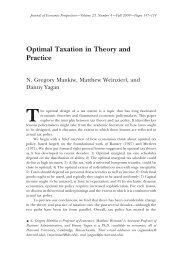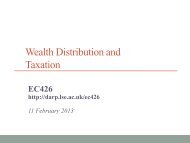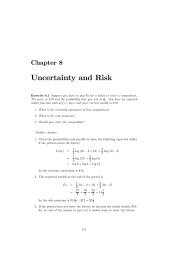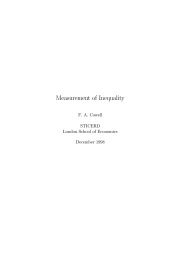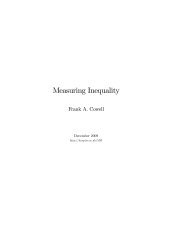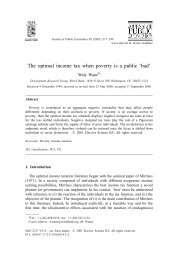Sacrifice principle and the Benefit principle of Taxation - DARP
Sacrifice principle and the Benefit principle of Taxation - DARP
Sacrifice principle and the Benefit principle of Taxation - DARP
Create successful ePaper yourself
Turn your PDF publications into a flip-book with our unique Google optimized e-Paper software.
<strong>Sacrifice</strong> Principle <strong>of</strong><br />
<strong>Taxation</strong><br />
<strong>and</strong> how it related with ranking <strong>of</strong> income distribution <strong>and</strong><br />
benefit <strong>principle</strong> in taxation
<strong>Sacrifice</strong> Principle <strong>of</strong> <strong>Taxation</strong><br />
a. What meaning can be given to <strong>the</strong> concept <strong>of</strong> equal<br />
sacrifice in taxation?<br />
Equal absolute sacrifice <strong>principle</strong> <strong>and</strong> equal<br />
proportionate sacrifice <strong>principle</strong><br />
b. What is its relationship to <strong>the</strong> ranking <strong>of</strong><br />
distributions in terms <strong>of</strong> inequality?<br />
c. How does Neill reconcile <strong>the</strong> sacrifice <strong>principle</strong> <strong>and</strong><br />
<strong>the</strong> benefit <strong>principle</strong>?
The Concept <strong>of</strong> Equal <strong>Sacrifice</strong> in <strong>Taxation</strong><br />
Equal absolute sacrifice <strong>principle</strong> originally introduced by<br />
Mill (1848): everyone should suffer <strong>the</strong> same absolute loss<br />
<strong>of</strong> utility (Young, 1990)<br />
U(x): utility given a income level x<br />
t: tax<br />
U (x) – U (x - t) = s ;<br />
for all income class.<br />
s is <strong>the</strong> constant level <strong>of</strong> sacrifice<br />
Calculating t : t = x – U -1 [ U (x) – s ]
The Concept <strong>of</strong> Equal <strong>Sacrifice</strong> in <strong>Taxation</strong><br />
Ideally, everyone has <strong>the</strong>ir own utility function<br />
Impossible in practice<br />
A more practical method: to consider U(x) as <strong>the</strong><br />
utility function <strong>of</strong> a “representative” member <strong>of</strong><br />
society (Robbins, 1939; Musgrave, 1959)<br />
Everyone in <strong>the</strong> society is treated as if <strong>the</strong>y had same<br />
utility function
The Concept <strong>of</strong> Equal <strong>Sacrifice</strong> in <strong>Taxation</strong><br />
Mill: using Bernoullian utility function<br />
Sacrificing same amount <strong>of</strong> utility if <strong>the</strong> percentage <strong>of</strong><br />
income sacrificed is same for all.
The Concept <strong>of</strong> Equal <strong>Sacrifice</strong> in <strong>Taxation</strong><br />
Equal proportionate sacrifice <strong>principle</strong> by Cohen<br />
Stuart (1889)<br />
Everyone should suffer <strong>the</strong> same relatively loss in<br />
utility.<br />
U( x – t )/ U( x ) = 1 – r ; where r is <strong>the</strong> rate <strong>of</strong> loss in<br />
utility.
The Concept <strong>of</strong> Equal <strong>Sacrifice</strong> in <strong>Taxation</strong><br />
Equal absolute sacrifice is <strong>the</strong> same as Equal<br />
proportionate sacrifice in recent <strong>the</strong>ory development.<br />
Ok (1995) demonstrated that, under certain minor<br />
restrictions, a progressive tax function equalizes <strong>the</strong><br />
level <strong>of</strong> absolute or proportional sacrifice according to<br />
a continuous, increasing <strong>and</strong> concave utility function
<strong>Taxation</strong> <strong>and</strong> Income Distribution<br />
Lorenz-domination in taxation: disposable income<br />
under T (tax system) L-dominates that under T* if <strong>and</strong><br />
only if residual progression <strong>of</strong> T is higher than that <strong>of</strong><br />
T* (Jakobsson , 1976)<br />
Residual progression <strong>of</strong> taxation<br />
[dc/dy][y/c] = [1 - T’(y)]/[1 – T(y)/y];<br />
where y is <strong>the</strong> pre-tax income, c is <strong>the</strong> post tax income<br />
<strong>and</strong> T(y) is tax under tax system T
<strong>Taxation</strong> <strong>and</strong> Income Distribution<br />
According to Young (1987), a continuous, nondecreasing,<br />
non-constant utility function U(x)<br />
corresponding to <strong>the</strong> taxation functions under <strong>the</strong><br />
requirement <strong>of</strong> equal sacrifice <strong>principle</strong> (whe<strong>the</strong>r<br />
absolute or relative) must be scale-invariant<br />
Scale-invariant utility function means U(x) exhibits<br />
constant relative risk aversion<br />
Constant relative risk aversion in U(x):<br />
U(x) = ( x 1-ε - 1)/(1-ε)<br />
where ε is a constant relative risk aversion
<strong>Taxation</strong> <strong>and</strong> Income Distribution<br />
Residual progression under equal absolute sacrifice<br />
approach<br />
<br />
Assume U (y) – U (y - t) = constant<br />
U(y) = ( y 1-ε - 1)/(1-ε)<br />
Residual progression <strong>of</strong> T (differentiate <strong>and</strong> rearrange)<br />
y –ε - [1 - T’(y)] [y – T(y)] –ε = 0<br />
RP = [1 - T’(y)]/[1 – T(y)/y] = [1 – T(y)/y] ε-1<br />
RP > 1 because ε > 1 (Cowell-Gardiner, 2000)<br />
If <strong>the</strong>re is no tax, T(x) = 0, residual progression is 1<br />
Tax system under equal sacrifice <strong>principle</strong> L-dominates no<br />
taxation
<strong>Sacrifice</strong> Principle <strong>and</strong> <strong>Benefit</strong> Principle<br />
<strong>Benefit</strong> <strong>principle</strong>: <strong>the</strong> taxes which an agent pays<br />
should reflect <strong>the</strong> benefit that he receives from<br />
<strong>the</strong> mix <strong>of</strong> goods <strong>and</strong> services supplied by <strong>the</strong><br />
public (Neil, 2000)
<strong>Sacrifice</strong> Principle <strong>and</strong> <strong>Benefit</strong> Principle<br />
Combination <strong>of</strong> benefit <strong>and</strong> equal sacrifice<br />
Consider a set <strong>of</strong> n agents with <strong>the</strong> same<br />
indirect, cardinal utility function, U( y ; x )<br />
y is <strong>the</strong> agent's income <strong>and</strong> x is <strong>the</strong> quantity<br />
<strong>of</strong> a public good that he consumes<br />
From equal sacrifice <strong>principle</strong><br />
U(y i – t i , x)- U(y i , x) = U(y j – t j , x)- U(y j , x);<br />
∀i, j;
<strong>Sacrifice</strong> Principle <strong>and</strong> <strong>Benefit</strong> Principle<br />
Combination <strong>of</strong> benefit <strong>and</strong> equal sacrifice<br />
If <strong>the</strong>re is no tax, government cannot afford<br />
public good<br />
U(y i – t i , x)- U(y i , 0) = U(y j – t j , x)- U(y j , 0);<br />
∀i, j;<br />
To optimized this equation, we take both<br />
sacrifice <strong>and</strong> benefit <strong>principle</strong> into consideration
Reference<br />
Cowell, F. A. <strong>and</strong> Gardiner, K.A. “Welfare Weights”, OFT Economic Research Paper<br />
202, Office <strong>of</strong> Fair Trading, Salisbury Square, London, 2000<br />
Jakobsson, U. “On <strong>the</strong> measurement <strong>of</strong> <strong>the</strong> degree <strong>of</strong> progression,” Journal <strong>of</strong> Public<br />
Economics, 5, 161-168, 1976<br />
Mill, John Stuart, Principles <strong>of</strong> Political Economy (1848), London: Longmans Green, 1917<br />
Musgrave, Richard, The Theory <strong>of</strong> Public Finance, New York: McGraw-Hill, 1959<br />
Neill, J. R. “The benefit <strong>and</strong> sacrifice <strong>principle</strong>s <strong>of</strong> taxation: A syn<strong>the</strong>sis,” Social Choice <strong>and</strong><br />
Welfare, 17, 117-124, 2000<br />
Ok, E. A. “On <strong>the</strong> Principle <strong>of</strong> Equal <strong>Sacrifice</strong> in Income <strong>Taxation</strong>”, Journal <strong>of</strong> Public<br />
Economics, 58(3), 453-467, 1995<br />
Robbins, Lionel, “Interpersonal Comparisons <strong>of</strong> Utility,” Economic Journal, 48, 635-41,<br />
1938<br />
Stuart, Cohen <strong>and</strong> Cohen, Arnold Jacob, (1889), “On Progressive taxation,” in<br />
R.A.Mussgrave <strong>and</strong> A. T. Peacock, eds., “Classics in <strong>the</strong> Theory <strong>of</strong> Public Finance,” New<br />
York: MacMillan, 1958<br />
Young, H. P. “Progressive taxation <strong>and</strong> <strong>the</strong> equal sacrifice <strong>principle</strong>,” Journal <strong>of</strong> Public<br />
Economics, 32, 203-212, 1987<br />
Young, H. P. “Progressive taxation <strong>and</strong> equal sacrifice,” American Economic Review, 80, 253-<br />
266, 1990



